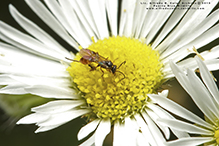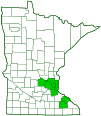Ichneumonid wasps
(subfamily Tersilochinae)
Overview • Description • Distribution • Taxonomy
The majority of Tersilochinae are internal parasites of butterflies and moths (Lepidoptera), but some are parasites of weevils (Curculionidae), some of leaf beetles (Chrysomelidae), and some of other beetle families. One species parasitizes the larvae of the plum curculio, an agricultural pest, and is used as a biological control agent of that weevil. The female uses her long ovipositor to insert an egg into the body of a host larva. The egg hatches very soon after being implanted. The host continues to develop as the larva feeds on it. |
||
Description |
||
Tersilochinae are small to medium-sized, inconspicuous wasps. Adults are 1⁄16″ to ⅜″ (2 to 9 mm) in length. The plate on the face (clypeus) is convex and often very broad. It is distinctly separated from the face by a groove. The jaws (mandibles) are long and slender and have two teeth. The antennae are short and, on most species, have fewer than 22 segments. The rear part of the body (gaster) is laterally compressed and usually smooth and shiny. The first segment is compressed into a slender petiole. The upper plate (tergite) and lower plate (sternite) are fused together. On the female, the egg-laying apparatus (ovipositor) may be short, not projecting beyond the tip of the gaster, or very long. If long, it is slightly to strongly curved upward or is wavy at the end. The legs are slender. The spurs at the end of the fourth segment of each leg are usually short and sometimes curved. The last part of each leg (tarsus), corresponding to the foot, has a pair of claws at the tip. The claws are usually simple, not split. The forewing has just a single intercubital vein. On the leading edge (costal margin), the marginal cell is deep, and the the thickened cell (stigma) is large and triangular. The slender petiole and unique wing venation make Tersilochinae easy to identify. |
||
Distribution |
||||
|
Sources |
|||
| 4/6/2023 | ||||
Taxonomy |
|||
Order |
Hymenoptera (Ants, Bees, Wasps, and Sawflies) | ||
Suborder |
Apocrita (Narrow-waisted Wasps, Ants, and Bees) | ||
Superfamily |
Ichneumonoidea (Ichneumonid and Braconid Wasps) | ||
Family |
Ichneumonidae (Ichneumonid Wasps) | ||
Subordinate Taxa |
|||
Genus Allophroides Genus Allophrys Genus Aneuclis Genus Aotearoazeus Genus Areyonga Genus Australochus Genus Barycnellus Genus Barycnemis Genus Ctenophion Genus Diaparsis Genus Epistathmus Genus Gauldiana Genus Gelanes Genus Heterocola Genus Horstmannolochus Genus Kiwi Genus Megalochus Genus Meggoleus Genus Palpator Genus Petilochus Genus Phradis Genus Probles Genus Sathropterus Genus Slonopotamus Genus Spinolochus Genus Stethantyx Genus Tersilochus Genus Zealochus |
|||
Synonyms |
|||
|
|||
Common Names |
|||
This genus has no common name. The common name of the family Ichneumonidae is Ichneumonid wasps, and it is applied here for convenience. |
|||
Glossary
Clypeus
On insects, a hardened plate on the face above the upper lip (labrum).
Costal margin
The leading edge of the forewing of insects.
Ovipositor
A tube-like organ near the end of the abdomen of many female insects, used to prepare a place for an egg and to place the egg.
Petiole
On plants: The stalk of a leaf blade or a compound leaf that attaches it to the stem. On ants and wasps: The constricted first one or two segments of the rear part of the body.
Stigma
In plants, the portion of the female part of the flower that is receptive to pollen. In Lepidoptera, an area of specialized scent scales on the forewing of some skippers, hairstreaks, and moths. In other insects, a thickened, dark, or opaque cell on the leading edge of the wing.
Visitor Photos |
|||||
Share your photo of this insect. |
|||||
| This button not working for you? Simply email us at info@MinnesotaSeasons.com. Attach one or more photos and, if you like, a caption. |
|||||
Alfredo Colon |
|||||
 |
|||||
MinnesotaSeasons.com Photos |
|||||
|
|||||

Slideshows |
||

Visitor Videos |
|||
Share your video of this insect. |
|||
| This button not working for you? Simply email us at info@MinnesotaSeasons.com. Attach a video, a YouTube link, or a cloud storage link. |
|||
Other Videos |
|||

Created: 4/6/2023
Last Updated:


